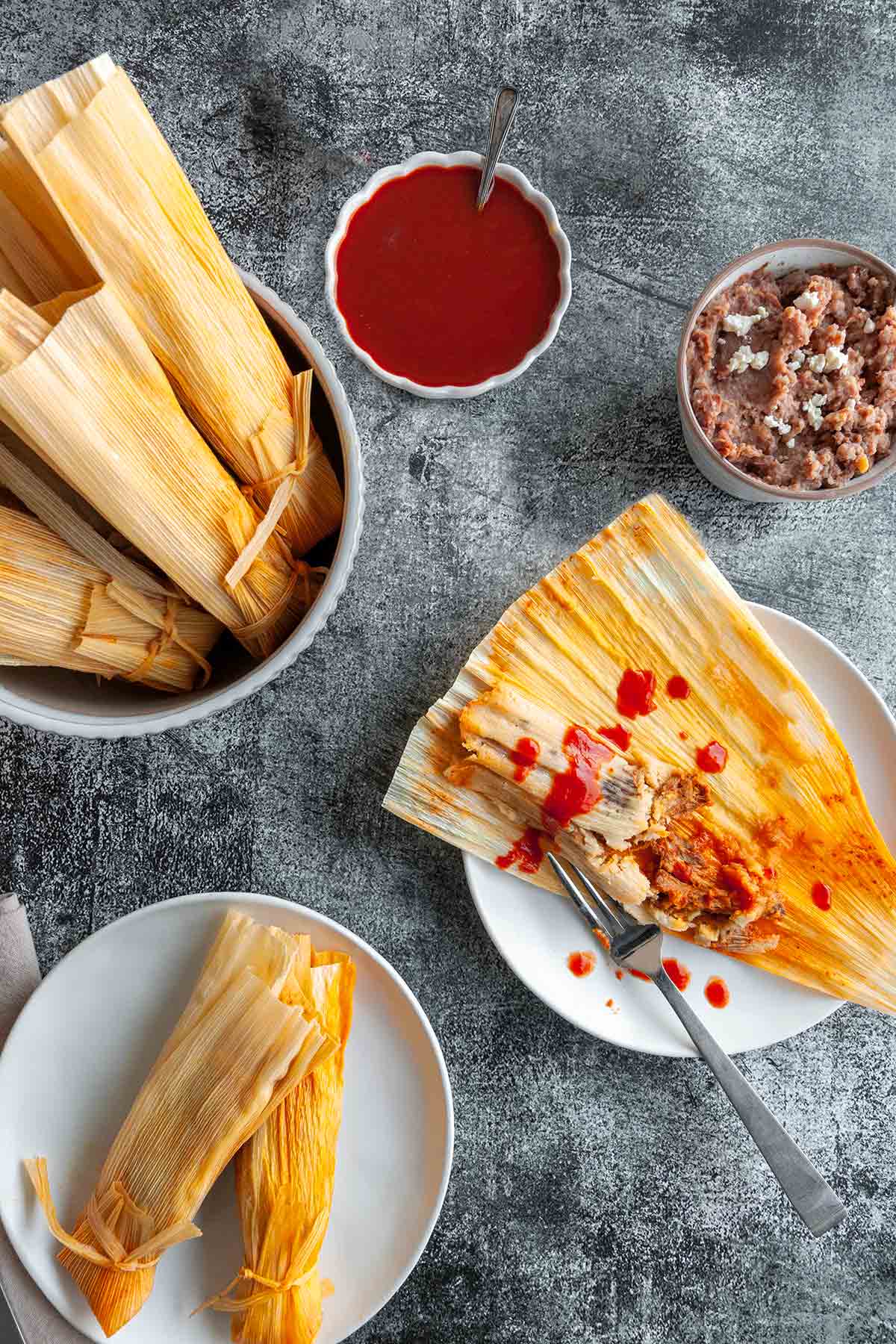
These red tamales are authentic Mexican through and through—sweet corn masa dough envelops a richly spiced, knee-wobblingly tender pork filling. Consider yourself warned, though. You’re going to end up with a holy abundance of red chile pork filling, which is actually a godsend, seeing as you can put it to great use tucked into pork tacos, plopped on rice, or simply inhaled by the forkful.

Why Our Testers Loved This
I’m not going to lie. Making this tamale recipe does require some time and effort. However, our testers will happily tell you that they’re worth every minute.
Carlin B. called them “a plateful of tasty comfort food,” and Sandy O. declared them to be “absolutely wonderful.” Makes you want to try them, doesn’t it?
Notes on Ingredients
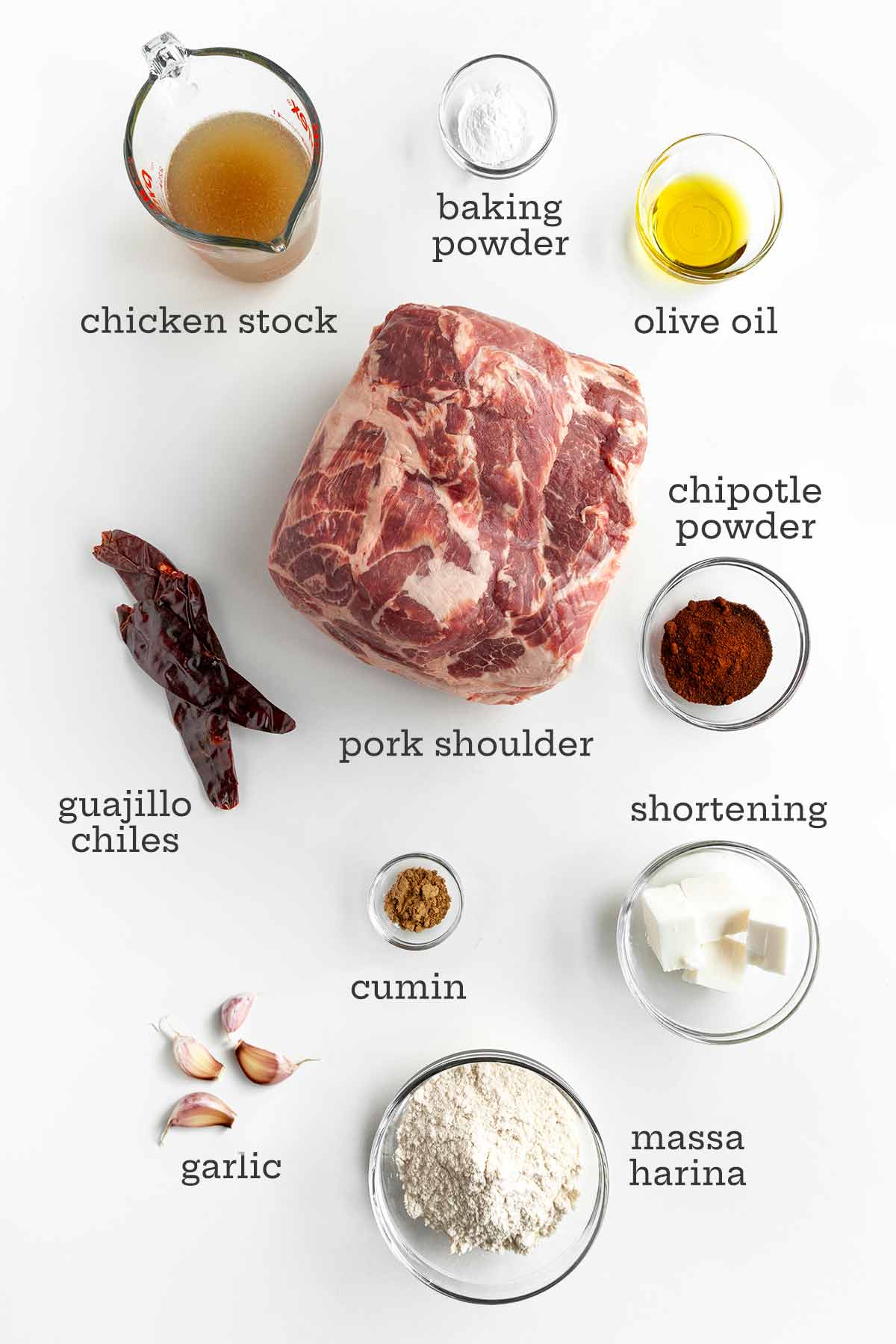
- Pork shoulder–You may see this labeled as Boston Butt at your store. Choose one that is well-marbled, as that will give you the most tender pork.
- Guajillo chiles–These are the dried form of the mirasol pepper and are commonly used in Mexican cooking. They’re available at some supermarkets and specialty grocers. If you can’t find them, dried ancho chiles would be the best substitute.
- Masa–This is flour that comes from ground nixtamalized corn (treated with an alkali) and is available in most major supermarkets. It is commonly used for making corn tortillas for tacos or tortilla soup.
- Corn husks–You’ll need about 32 husks for this recipe. A 1-pound bag contains between 80 and 100 husks.
How to Make Tamales
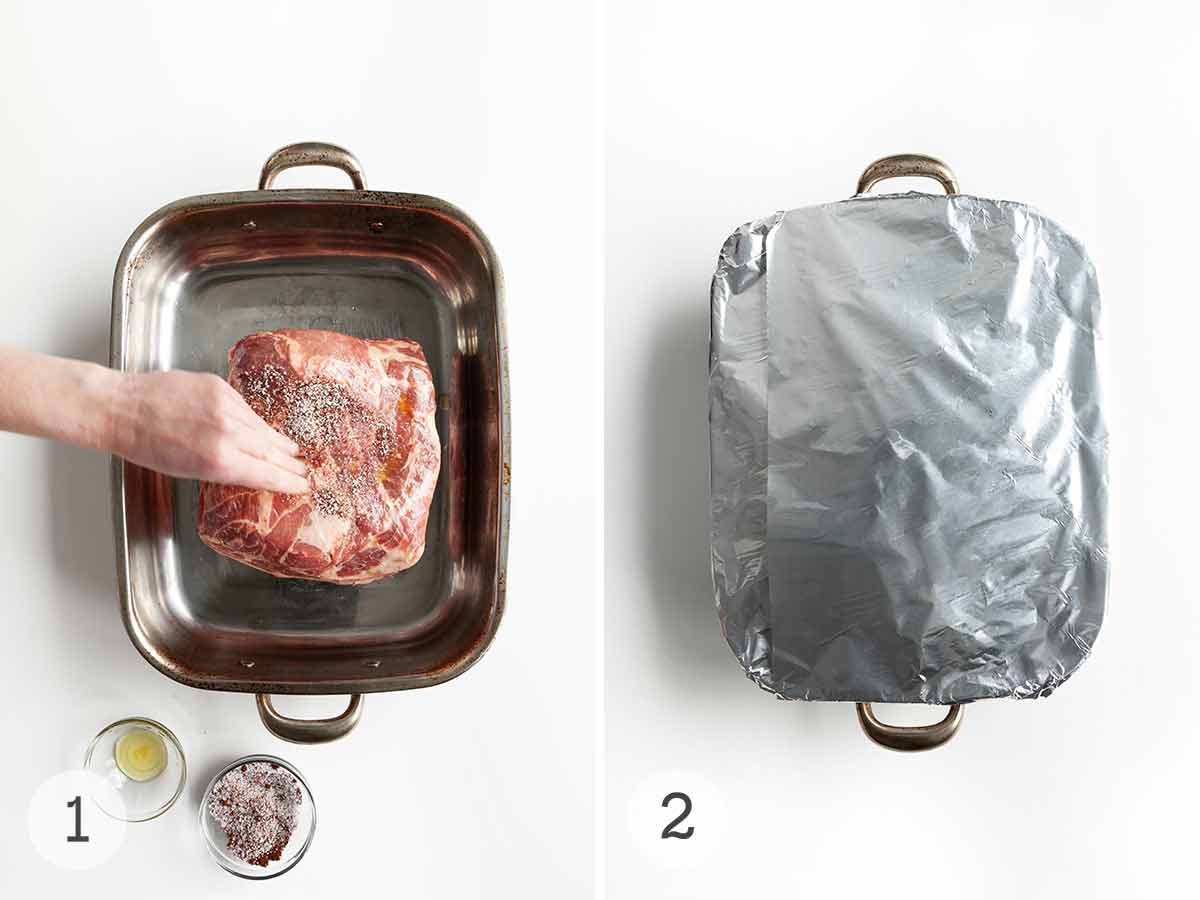
- Pat the pork dry and rub it all over with olive oil. Combine 4 tablespoons of salt with the chipotle pepper and rub all over the shoulder. Let rest at room temperature for 1 hour.
- Heat the oven to 275°F. Place the pork shoulder in a roasting pan, cover with two layers of foil, and roast until tender and falling apart. Let the pork cool for 30 minutes.
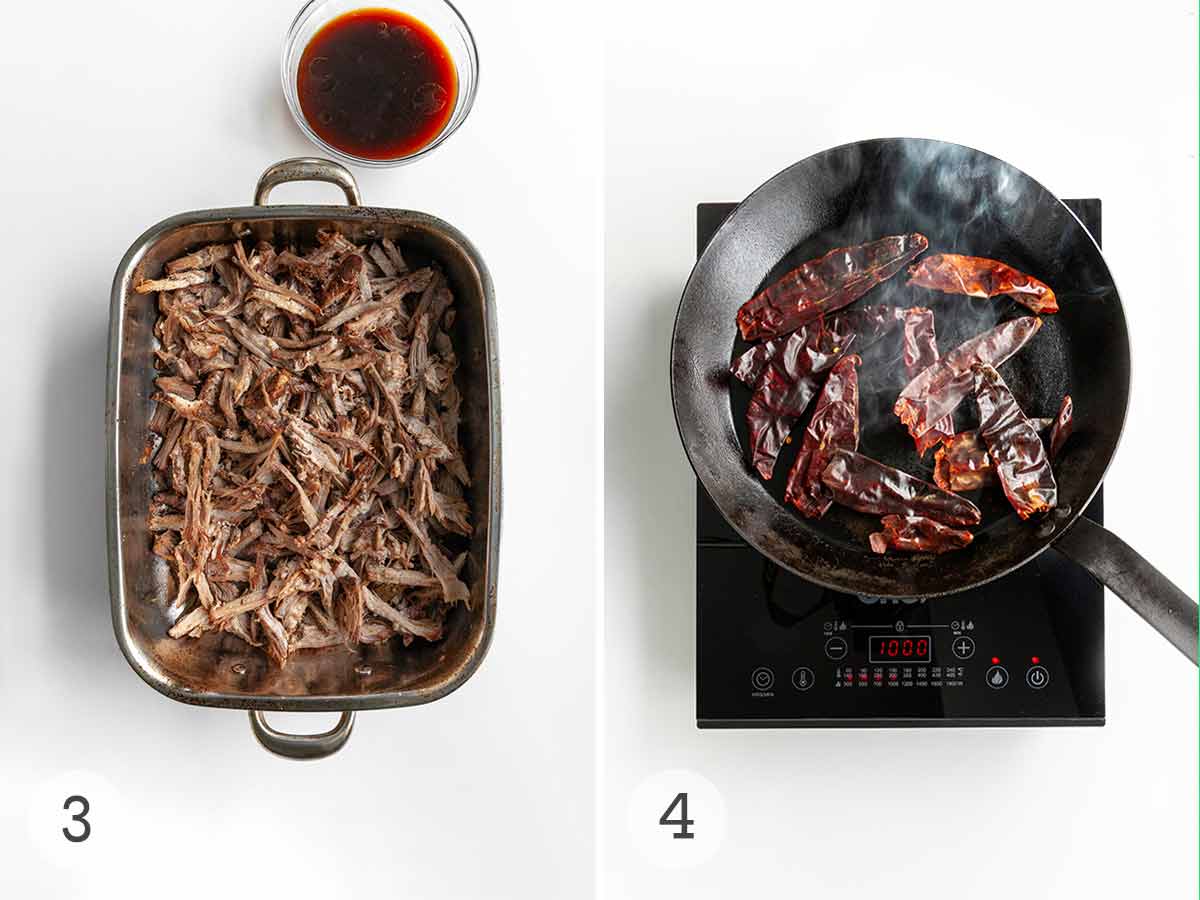
- Shred the pork. Discard any gristle, strain, and reserve the cooking liquid.
- Toast the chiles in a hot skillet for about 30 seconds per side. Place in a bowl, cover with hot water, and let them soak for 30 minutes.

- Blend the soaked chiles, garlic, cumin, 1 teaspoon of salt, and cold water until smooth. Heat 1 tablespoon of oil in a large pot until very hot. Add the chile puree and cook until it darkens.
- Stir the pork and cooking liquid into the pot. Simmer for 15 minutes. Let cool slightly before assembling the tamales.
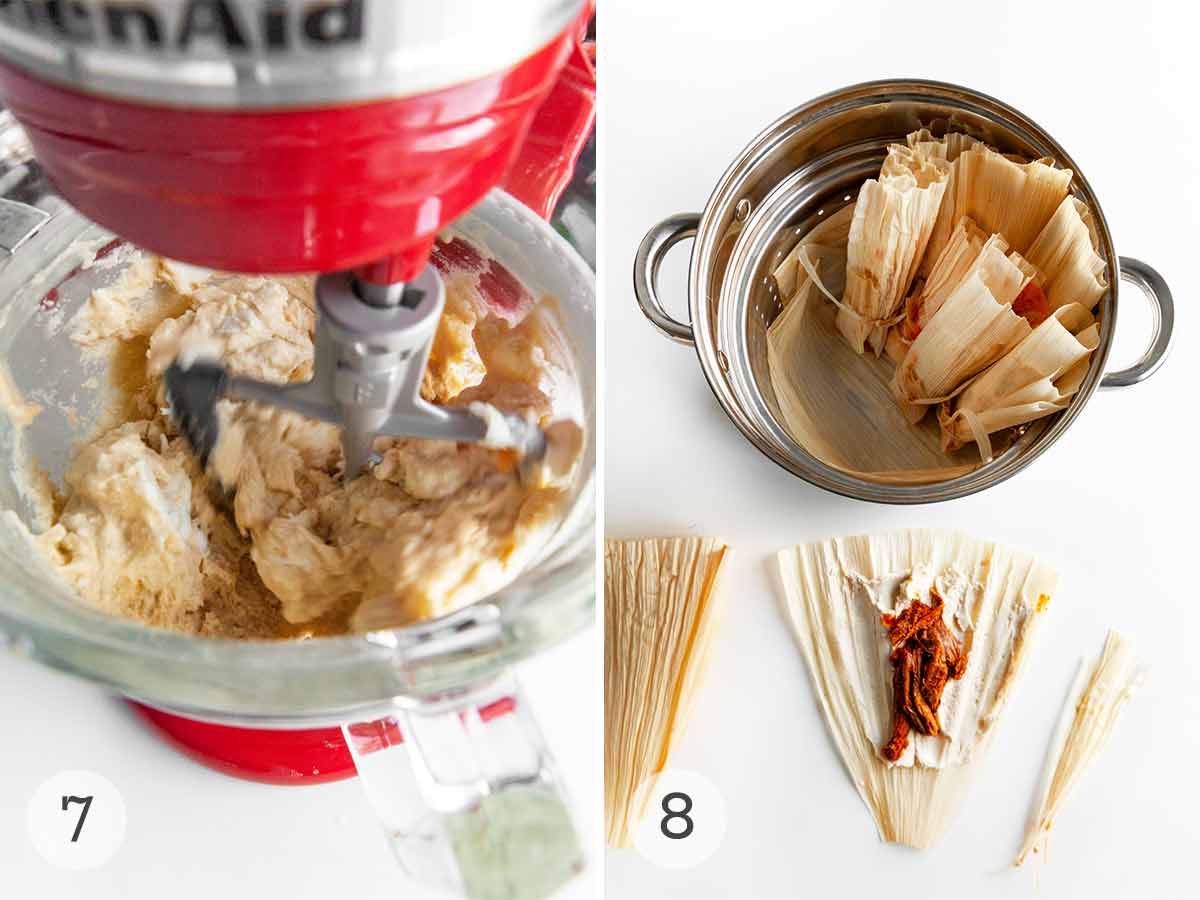
- Make the tamale dough. Mix together the masa and water, then add in the lard, baking powder, stock, and salt and mix well. Soak the corn husks in water until pliable then pat dry. Tear a few husks into 1/2-inch strips and tie a knot at the end to create ties for the tamales.
- Fill the tamales. Working with one husk at a time, spread 1/4 cup of the masa harina over the smooth side (inside) of the husk, leaving a 1/2-inch border. Top with 2 tablespoons of the pork, then roll the tamale and secure the bottom with one of the ties, leaving the top open.
- Prepare a steamer in a large stockpot partially filled with water. Stand the tamales upright in the steamer and cook until the masa pulls away from the husks, adding water as needed. Let the tamales rest in the steamer until they begin to firm up before serving.
Recipe FAQs
Tamales are a Mexican dish made with tender masa dough and filling steamed inside a corn husk until tender. They’re popular year-round, but particularly during the Christmas holidays, which makes them a great addition to holiday potluck menus. The masa dough can be filled with pork, beef, chicken, and even vegetables, as in these sweet potato tamales.
These Mexican pork tamales can be topped with mole, sour cream, salsa, a squeeze of lime juice, and cotija cheese. If you’re looking for side dishes, try serving them with refried beans, rice, or Mexican corn. Don’t forget biscochitos for dessert.
To eat the tamale, remove the corn husk from around the filling. You can either discard the husk or use it as a plate. Eat the masa filling with your fingers or a fork and knife.
Storing, Freezing, and Reheating Tamales
These red chile tamales can be refrigerated for up to 3 days after cooking or frozen for up to 6 months. Cool the tamales completely before placing them in an airtight container or resealable plastic bag. If frozen, let them thaw in the refrigerator before reheating.
To reheat pork tamales, line your steamer basket with a few corn husks, then place the tamales in the basket. Set it over a pan of simmering water and let the tamales steam gently until they’re heated through, about 30 minutes.
Pro Tips
- The cooking time for the pork can vary significantly, depending on the thickness and starting temperature of your pork butt. Be patient! The low and slow cooking method ensures tender, shreddable meat.
- Extra pulled pork filling can be used in tacos, sandwiches, enchiladas, or as a topping for a rice bowl. You can freeze it in a sealed container or resealable bag for up to 3 months.
- When filling your pork tamales, make sure you spread the filling on the smooth side of the husk. This will allow the filling to release easily from the corn husk.
- Store unused corn husks in a plastic bag in a cool dry place for up to 6 months.
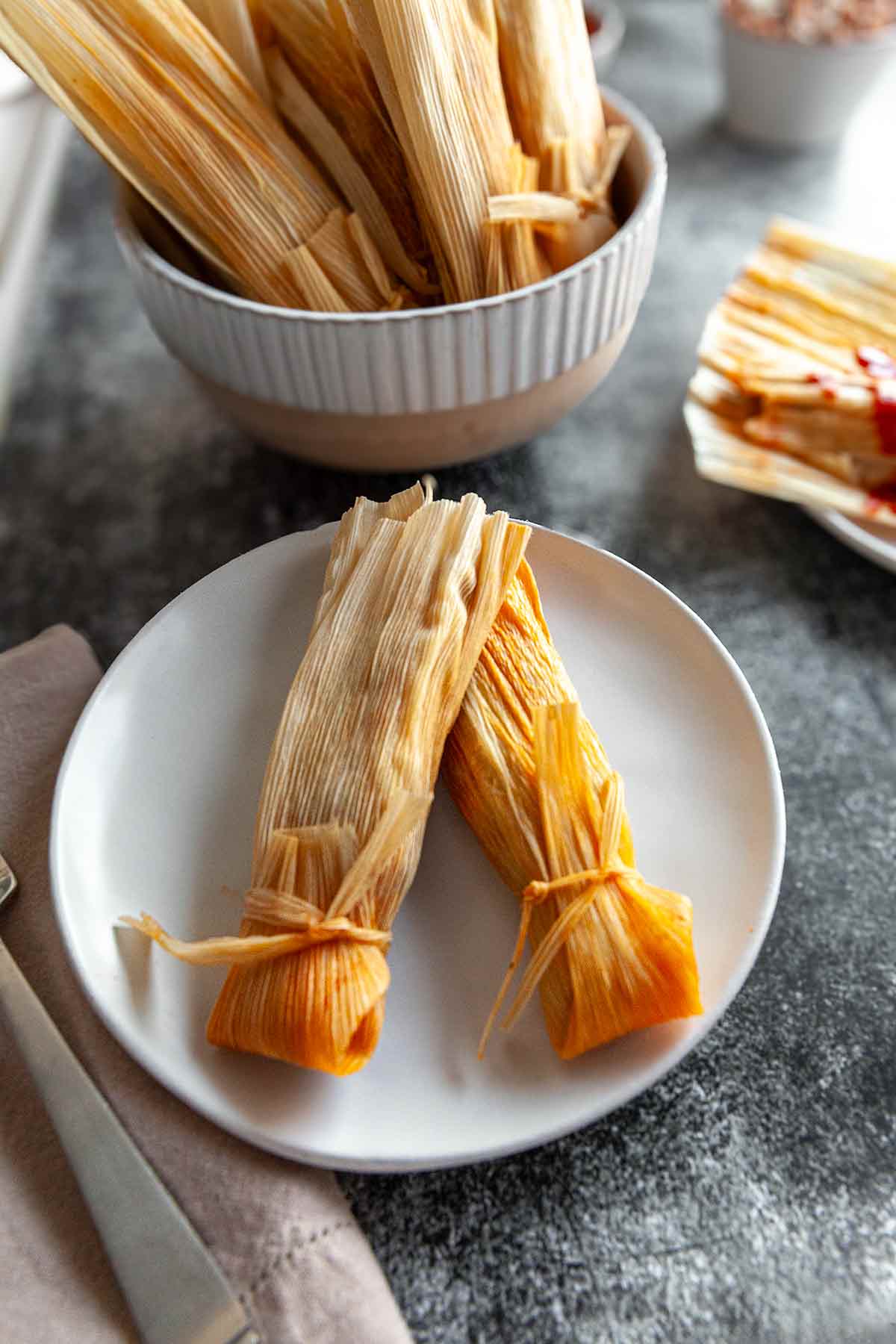
Write a Review
If you make this recipe, or any dish on LC, consider leaving a review, a star rating, and your best photo in the comments below. I love hearing from you.–David
This is THE BEST tamale recipe. I’ve been using it for a couple of years now and always get compliments that they’re “the best tamales they’ve ever had!” Thank you so much for sharing this recipe!
shelly
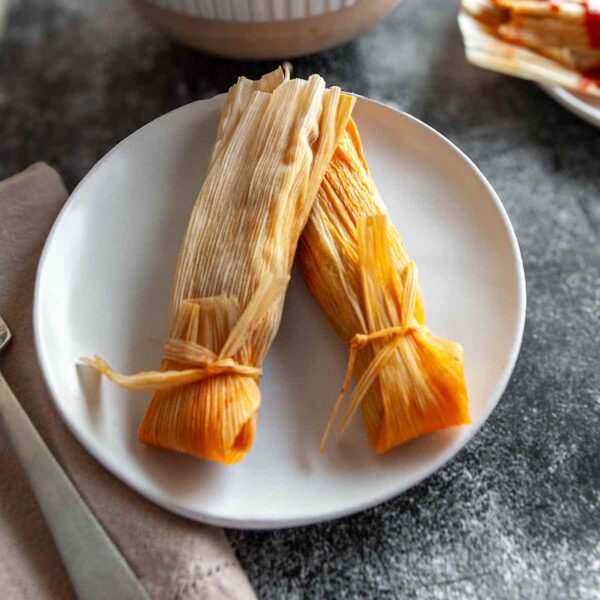
Red Chile Pork Tamales
Equipment
- Bamboo steamer or steamer tray for your stockpot
Ingredients
For the red chile pork tamales filling
- 5 pounds pork shoulder
- 1 tablespoon mild olive oil or vegetable oil, plus more for coating the pork
- 4 tablespoons plus 1 teaspoon kosher salt
- 2 tablespoon chipotle powder
- 14 dried guajillo chiles, seeded and stemmed
- 6 garlic cloves
- 1 teaspoon ground cumin
- 3 cups cold water
For the tamale dough
- 3 1/2 cups masa harina
- 2 1/4 cups warm water
- 10 ounces lard or vegetable shortening
- 1 1/2 teaspoon baking powder
- 1 1/2 cups chicken stock or vegetable stock
- 2 teaspoons kosher salt
- 32 dried corn husks
Instructions
Make the red chile pork tamales filling
- Pat the pork shoulder completely dry with paper towels. Rub the pork shoulder all over with just enough oil to coat it.
- In a small bowl, combine 4 tablespoons (60 grams) salt with the chipotle powder. Rub the mixture on the pork, completely covering all surfaces. Let the pork rest at room temperature for 1 hour. (But for no longer than 1 hour or the salt will draw moisture from the pork and make it tough.)
- Preheat the oven to 275°F (135°C).
- Place the pork in a roasting pan, fatty side down. Cover the pan with a double layer of aluminum foil and roast for 3 1/2 to 4 hours, until the pork falls apart when pressed with the back of a fork and reaches an internal temperature of 195°F (91°C). Remove the pork from the oven and let it rest, without uncovering, for 30 minutes.
- After the pork has cooled for 30 minutes, use 2 forks to pull the pork into long strands. Resist the temptation to chop the pork into chunks! Discard any gristle or chunks of fat. Strain the cooking liquid. You should have anywhere from 2 to 4 cups (473 to 946 ml) of liquid.
- Meanwhile, heat a cast iron skillet or heavy-bottomed skillet over medium-high heat. Once the skillet is hot, toss in the chiles and cook for approximately 30 seconds per side, until they’re slightly toasty. Be careful not to over toast the chiles or let them blacken or the resulting sauce will be bitter.
- Remove the toasted chiles from the pan and place in a bowl. Add enough hot water to submerge the chiles. Let the chiles soak for 30 minutes.
- After 30 minutes, use a slotted spoon to transfer the soaked chiles to a blender and discard the soaking liquid. Add the garlic, cumin, remaining 1 teaspoon salt, and cold water to the blender. Puree until the mixture forms a smooth paste.
- Heat the 1 tablespoon (15 ml) oil in a heavy, large stockpot over medium-high heat. When the oil is very hot and begins to shimmer, pour the red chile sauce into the pot and immediately stir. Be careful as the sauce will splatter. Cook the sauce, stirring constantly, for 2 to 3 minutes, until the sauce thickens and begins to darken.
- Add the reserved pork drippings and the pulled pork. Bring the mixture to a simmer and gently cook, uncovered, for 15 minutes.
- Let the red chile pork filling cool slightly before preparing the tamales. (You can cover and refrigerate the pork overnight.)
☞ TESTER TIP: You’ll have a lot of red chile pulled pork, so you’ll need to either make a double batch of tamale batter or be prepared to serve the leftover pork in soft tortillas or over rice or in any of countless other incarnations.
Make the tamale dough
- In a large bowl or the bowl of stand mixer, blend the masa harina with the warm water. Stir the mixture thoroughly to create a solid ball of rehydrated masa. Add the lard, baking powder, stock, and salt, whisking thoroughly or, if you are using a mixer, blend on medium speed for approximately 5 minutes. Set the mixture aside until ready to assemble the tamales.
Assemble the tamales
- Separate the corn husks and place them in a large bowl or your kitchen sink and add enough warm water to completely submerge them. Let the husks soak until they become relatively soft and pliable, at least 30 minutes.
- Remove the husks from the water, separate completely, and pat them dry with a clean towel.
- Prepare the ties for your tamales by tearing several of the husks into strips 1/2 inch (1.3 cm) wide until you have 24 strips. Gently tie a knot at a narrow end of each strip and tear the opposite end to double the strip length to about 12 inches (30.5 cm) long. Repeat with the remaining strips.
- Place a large corn husk on a clean flat surface with the shortest side facing you and the smooth side facing up. Spoon approximately 1/4 cup (60 grams) masa dough on the upper center of the husk and, using a butter knife or the back of the spoon, spread it into a square shape across the width of the husk to approximately 1/4 inch (6 mm) thick. Be sure to leave approximately 1/2 inch (13 mm) on the top and sides of the husks plain to allow for easier rolling.
- Spoon approximately 2 tablespoons (30 grams) pork mixture in an even line along the center of the masa and gently fold the husk over widthwise to completely encase the filling and form a tight tube. Fold the bottom of the husk up toward the center of the tamale and tie with the prepared strip of corn husks. Be sure to leave the top of the husks open. Repeat with the remaining corn husks and masa dough.
- Fill a large stockpot 1/4 full with warm water and bring to a boil over medium-high heat. Line a steamer basket with several unfilled corn husks. Place the prepared tamales upright with the open tops facing towards the top of the steamer basket and top with additional corn husks. It's perfectly fine (and actually necessary) to stack the tamales one atop another.
- Cover the steamer basket with a tight-fitting lid and place on top of the stockpot with the boiling water and steam until the batter pulls away easily from the husks, checking occasionally to see if the pot needs to be replenished with water, about 1 hour total.
☞ TESTER TIP: When heating the water to cook the tamales, drop a clean coin in the pot. As the water boils, the coin will rattle, letting you know that the water has not boiled dry. If the coin stops rattling, you know that it’s time to add more water. Or just set your iPhone timer for every 10 or 15 minutes and check the water level.
- Turn off the heat and let the tamales rest in the basket for at least 30 minutes, until they begin to firm. And then dig in! (It's astounding how quickly tamales disappear in contrast to how long it takes to make them!)
Notes
- Leftover pork–Extra pulled pork filling can be used in tacos, sandwiches, enchiladas, or as a topping for a rice bowl.
- Filling tips–When filling your tamales, make sure you spread the filling on the smooth side of the husk. This will allow the filling to release easily from the corn husk.
- Storage–Store leftover tamales in a sealed container or resealable bag in the refrigerator for up to 3 days. Gently reheat in a steamer.

Nutrition
Nutrition information is automatically calculated, so should only be used as an approximation.
Recipe Testers’ Reviews
OH MY GOODNESS!! These red chile pork tamales were delicious! Despite my feeble attempt at wrapping, folding, and tying, these red chile pork tamales looked terrific!! And they tasted absolutely fantastic.
The taste of the corn perfectly balanced the seasoned red chile pork. The mixture of chile powder and salt was the ideal amount. Once the pork was covered with chile salt and had come to room temperature, I popped everything in the oven and roasted it for about 4 1/2 hours. I removed it from the oven and let it rest until cool enough to handle, a little over an hour.
Shredding the pork
Shredding the pork took me about 30 minutes. (It was a large piece of meat and still quite warm.) While the pork was cooling, I seeded the peppers and toasted them in a skillet. Although 14 seemed like a considerable amount, I followed the recipe exactly.
After covering the peppers with hot water and letting them sit for 30 minutes, I threw them in my food processor with garlic, cumin, and salt. The addition of the water helped loosen the mixture and turned it sauce-y. I poured the sauce into the pot and stirred constantly. It didn’t change color or thicken up much.
While the meat was cooling, I weighted the husks in water in the sink for about an hour to soften. I also made the dough at this time. I used shortening instead of lard. The dough came together very nicely, although it was a large amount.
An assembly line is the best for making the tamales
I cleared my counter and lined up the meat, husks, and dough in a row with my steamer pot to the right. Here comes the “fun” part. Since I’ve never made tamales, I followed the directions on spreading and filling the husks. My husks were nicely softened, but when I went to spread the dough, the husks tore.
Adding the meat was pretty easy, but the wrapping part was a fiasco! I did my best to take my time and carefully fill and wrap. I tried wrapping them up with the strips of husk, but after a few, I just stopped trying to tie them. Some of my tamales were fuller than others, and they were in no way uniform, but I kept on filling them.
Cooking the tamales
After stuffing three dozen, my pot was full, and I had plenty of dough and meat left over. I steamed the tamales for 55 minutes until the dough pulled away easily from the husks. I removed the steamer basket from the heat and let the tamales rest while I finished cleaning up.
This is a very time-consuming and fairly labor-intensive dish. I had more dirty pots, pans, and bowls than I could ever remember having for one dish!
Next time, I probably will have to consider cutting the recipe in half and inviting friends and family over to help cook and devour the tamales!
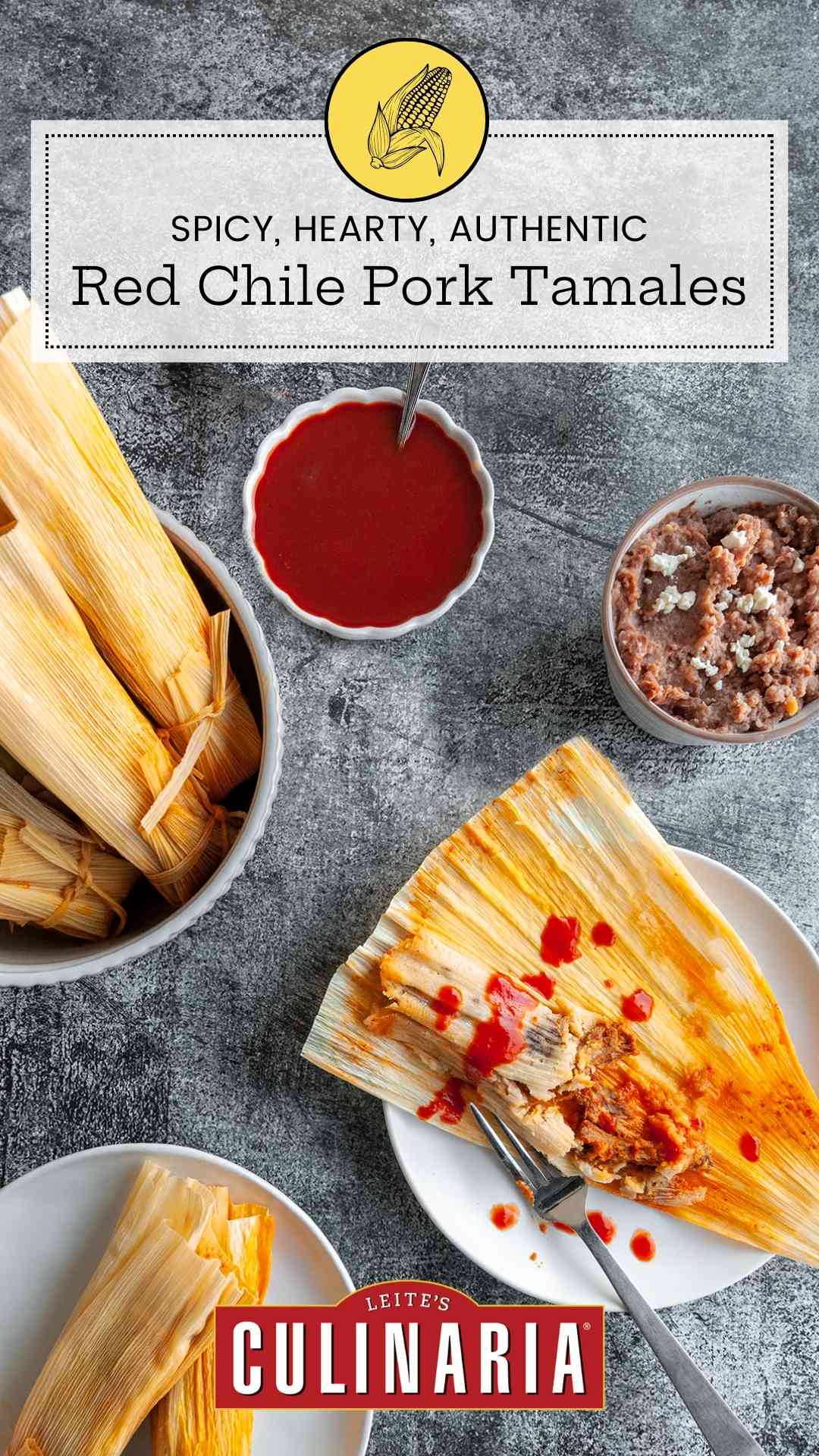
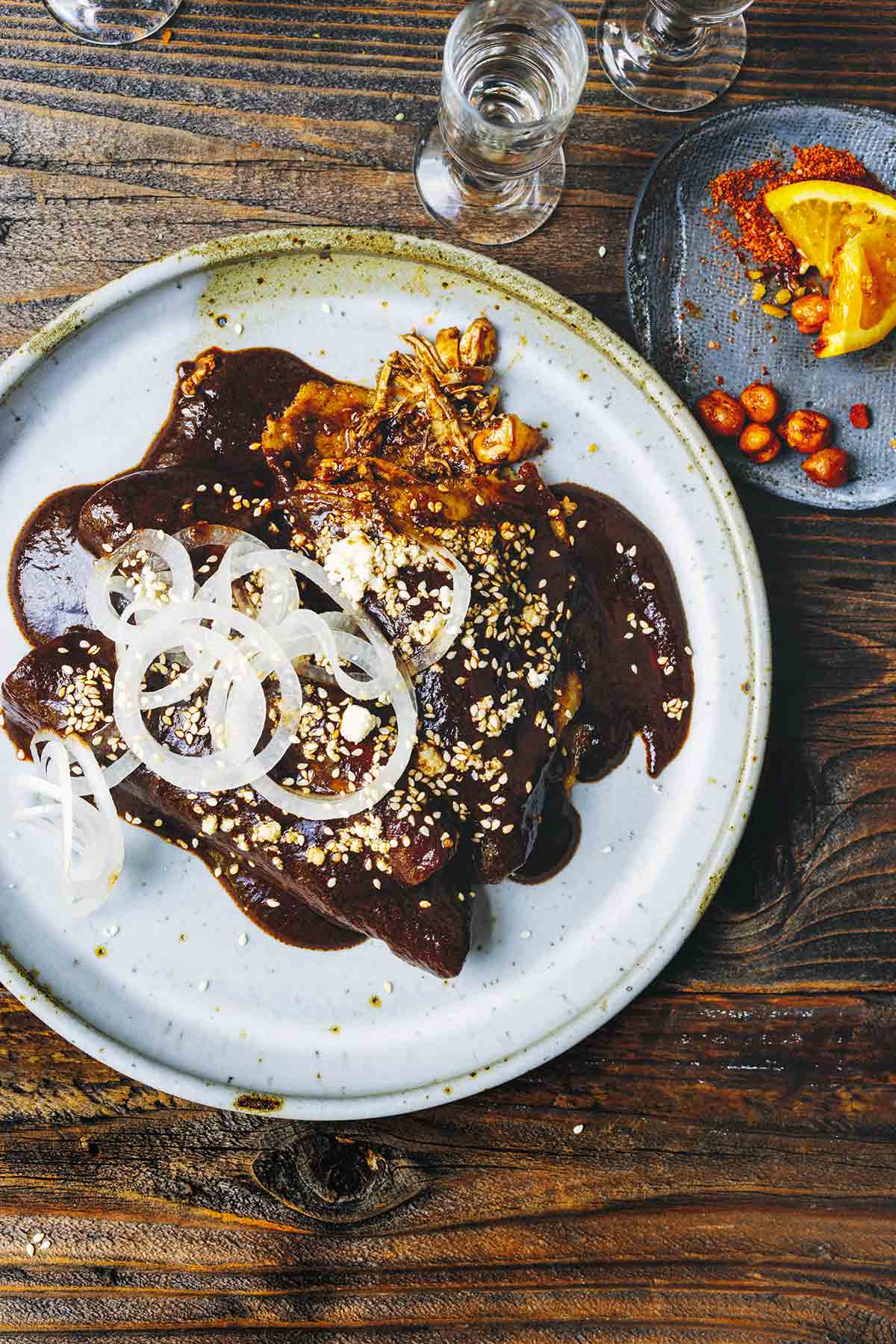
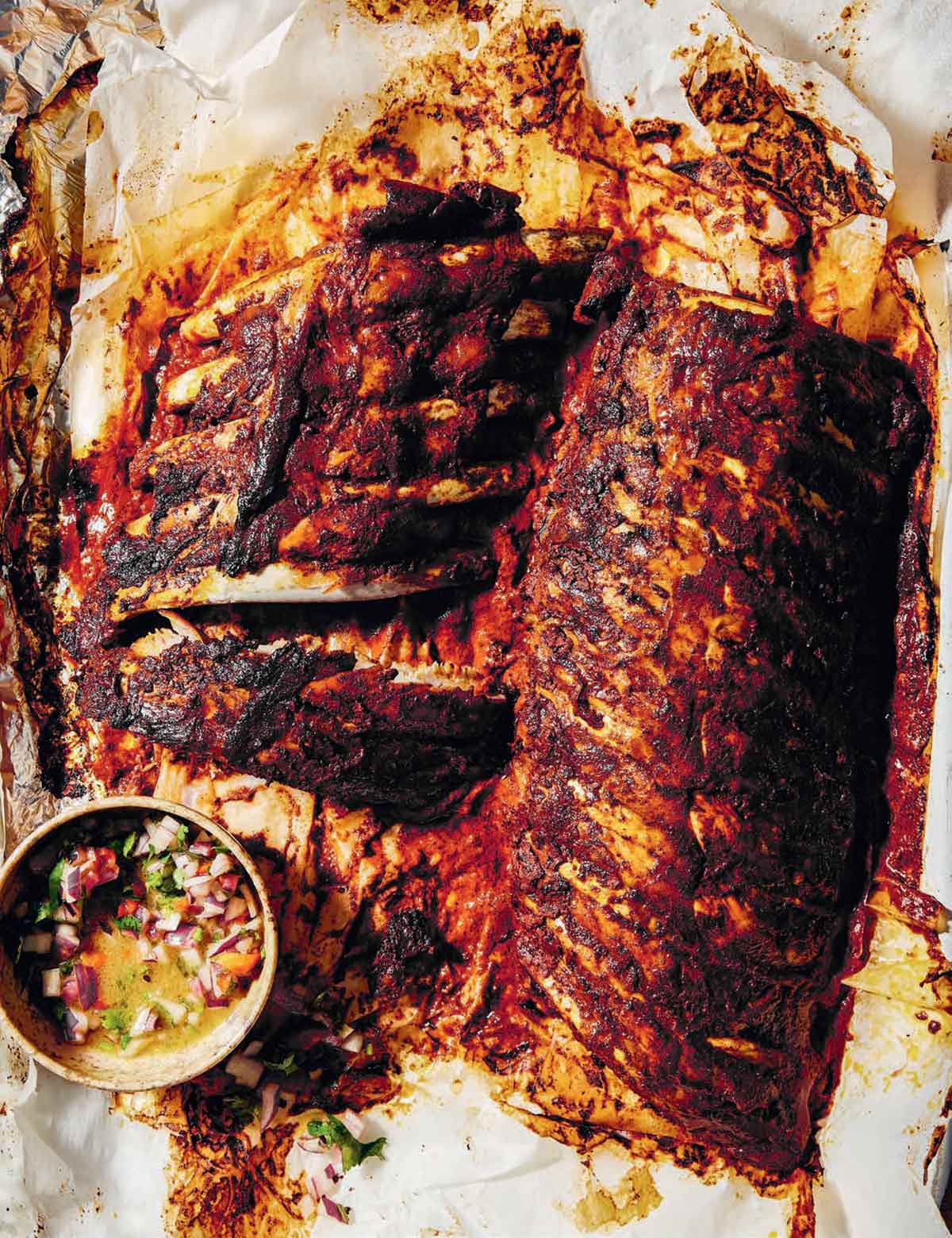










Had pork shoulder left over from Tourtiere making. Saved for tamales. Chinese husband from SoCal grew up with Mexican Christmas tamales. I’ve only made once before, and what a production! Good fun with friends. Tonight I’m doing a version of this, pork was already braised, now shredding/simmering in a salsa rosa including onions cooked in my achiote oil, hatch chiles, some tomatoes, guajillos….Just about to start assembly then cooking in Instant Pot! Assembling is likely to take longer than cooking! Stay tuned…
Jacqueline, yes, the assembling does so often take the longest with tamales! And yet if you enlist some help it makes things go more quickly as well as more pleasurably. Well, we can’t guarantee the latter, I guess it depends on whose company you take, but yes, please let us know how it goes!
The second sentence in instruction #15 is unclear: And then you can tuck into the tamales. Does this refer to tucking in the open ends of tamales?
Donna, actually, no, the phrase “tuck into” was something my dad would always say before he was about to devour something he was really excited about, as in, “let’s tuck into this apple pie!” Sorry for the confusion! I can completely understand how it would be baffling. I’ve reworded it to hopefully be clearer. Thanks so much for inquiring and looking forward to hearing what you think of the tamales!
What is the difference between regular masa & instant masa?
That’s an excellent question, Dusty. Instant masa is sorta like the equivalent of corn ground so finely as to be almost flour. You use it and water to make masa dough. So masa is the actual dough you make from the instant masa. We specify “instant masa” because that’s often how you see packages labeled at stores. It’s essentially “masa harina.” Our understanding is that it’s “instant” compared to the most traditional form of masa dough, which was made from corn that had to be soaked and ground and so on.
Christmas in many Mexican households means tamales. With many mouths to feed, it’s traditional to have the grandmothers, mothers, sisters, cousins, etc. in the kitchen tamales. They call it a Tamalada.
One alternative is, if your lucky enough to have a small Mexican grocery nearby, is to ask the owner if they make tamales. At our local market, the wife of the owner makes them by request. This particular market also makes their own masa and fresh tortillas.
Indeed, Christmas means tamales! Hence our timing of the recipe. Thanks so much for sharing the mention of the tamalada—love that!
I can’t wait to make these. This is the recipe I’ve been looking for, it’s the way I remember making tamales with my mom and grandma whom are no longer around. Thanks for a traditional recipe!
You’re so very welcome, Kymberly! And we love that you are carrying on the tradition. Food is so much more than simply…food. Can’t wait to hear what you think…!
Quick question before I attempt these bad boys! About how full does the pot need to be filled with water? Do the tamales need to be completely covered with water without the tips poking out? Also can you double stack the tamales in the tamal pot? I think I recall that pot always being filled to the top with tamales….
Kymberly, excellent questions. The water just needs to be enough to create steam. In my (admittedly limited) experience, you don’t want the tamales to be in the water, even the bottom portion of the tamales. And definitely not submerged. The water simply serves as a means to create moist heat. And yes, you can absolutely stack the tamales. We so appreciate you asking these clarifying questions!